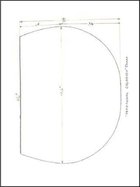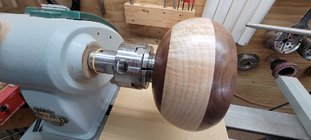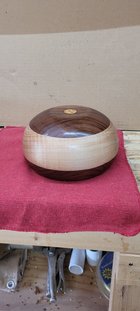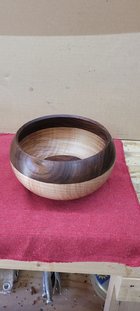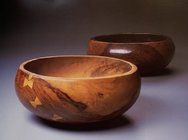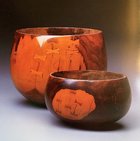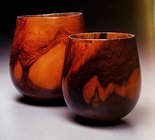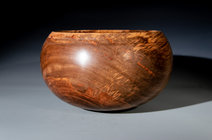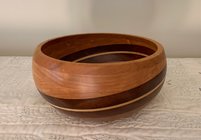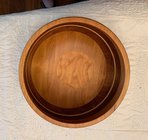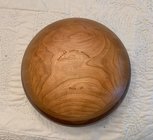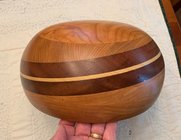I am going to try and make my first calabash bowl this weekend. Emiliano or anyone else have any tips.
-
April 2025 Turning Challenge: Turn an Egg! (click here for details) -
Congratulations to Kelly Shaw winner of the March 2025 Turning Challenge (click here for details) -
Congratulations to Ellen Starr for "Lotus Temple" being selected as Turning of the Week for 21 April, 2025 (click here for details) -
Welcome new registering member. Your username must be your real First and Last name (for example: John Doe). "Screen names" and "handles" are not allowed and your registration will be deleted if you don't use your real name. Also, do not use all caps nor all lower case.
You are using an out of date browser. It may not display this or other websites correctly.
You should upgrade or use an alternative browser.
You should upgrade or use an alternative browser.
Calabash bowl
- Thread starter Rusty Nesmith
- Start date
There are a lot of different types of Calabash bowls. The picture shows ancient Calabashes from the Bishop Museum collection. They could be as old as 300 to 400 years old and older. It should be easy for you to do it with HSS tools; they use fire and stone adzes, LOL. The sketch is a side grain calabash. The apex is always 1/3 of the way up. They are all round bottom, no foot or recess.
Attachments
What is the wall thickness like on these? Should it be consistent all the way around the bottom?
Thanks Emiliano. Perfect timing. I am leaving in 10 minutes to head down to the club and turn it.
What are the specific ‘rules’ as to what can be called, “Calabash”?
Ive been enjoying making this form, although I admit that I may not be doing all of the thing s necessary to call my ‘generally barrel shaped bowl with a round bottom’ a Calabash. Maybe my proportions don’t fit. Maybe, especially when working with softer wood, mine might have thicker walls. I’ve been putting a few lines on mine.
Someone in my local guild told me that my calabash offering were incorrect because the rim didn’t flare. (And about that flare thing, Emiliano explained to us at our remote demo, that the flared rims where there to hold the, now missing, lid. Shouldn’t new makers of the form include a lid?)
Maybe I’m very aware of definitions, especially in this case because we are fortunate to have a bonafide master in Emiliano.
I also do 90% of my turning with a 40-40ish gouge. You see, I shape and sharpen the gouge on a Wolverine jig.
I don’t want the terminology police to come after me, nor the Stu Batty devotees. Same problem with the calabash.
“Calabash” Is it a general idea (resembles the gourd for which it’s named)? Or is it as specific as some folks would lead one to believe?
Ive been enjoying making this form, although I admit that I may not be doing all of the thing s necessary to call my ‘generally barrel shaped bowl with a round bottom’ a Calabash. Maybe my proportions don’t fit. Maybe, especially when working with softer wood, mine might have thicker walls. I’ve been putting a few lines on mine.
Someone in my local guild told me that my calabash offering were incorrect because the rim didn’t flare. (And about that flare thing, Emiliano explained to us at our remote demo, that the flared rims where there to hold the, now missing, lid. Shouldn’t new makers of the form include a lid?)
Maybe I’m very aware of definitions, especially in this case because we are fortunate to have a bonafide master in Emiliano.
I also do 90% of my turning with a 40-40ish gouge. You see, I shape and sharpen the gouge on a Wolverine jig.
I don’t want the terminology police to come after me, nor the Stu Batty devotees. Same problem with the calabash.
“Calabash” Is it a general idea (resembles the gourd for which it’s named)? Or is it as specific as some folks would lead one to believe?
Updat. This is where my bowl is so far. More sanding and finish.
Looks like it'll turn out nicely, Rusty.....
Are you using a thread adaptor?
-----odie-----
Yes. The Chuck is a G3 with a 1”-8 thread and my lathe is 1.25-8 thread.Looks like it'll turn out nicely, Rusty.....
Are you using a thread adaptor?
-----odie-----
I made the lip 90 degrees to the side of the bowl instead of flat. I just thought that looked better.
What are the specific ‘rules’ as to what can be called, “Calabash”?
Ive been enjoying making this form, although I admit that I may not be doing all of the thing s necessary to call my ‘generally barrel shaped bowl with a round bottom’ a Calabash. Maybe my proportions don’t fit. Maybe, especially when working with softer wood, mine might have thicker walls. I’ve been putting a few lines on mine.
Someone in my local guild told me that my calabash offering were incorrect because the rim didn’t flare. (And about that flare thing, Emiliano explained to us at our remote demo, that the flared rims where there to hold the, now missing, lid. Shouldn’t new makers of the form include a lid?)
Maybe I’m very aware of definitions, especially in this case because we are fortunate to have a bonafide master in Emiliano.
I also do 90% of my turning with a 40-40ish gouge. You see, I shape and sharpen the gouge on a Wolverine jig.
I don’t want the terminology police to come after me, nor the Stu Batty devotees. Same problem with the calabash.
“Calabash” Is it a general idea (resembles the gourd for which it’s named)? Or is it as specific as some folks would lead one to believe?
In NC I would not worry about it. You can call anything you turn a calabash and nobody would know the differecce. In Hawaii we are trying to reproduce what the ancient Hawaiians did for hundreds of years. It is a tradition here, a part of culture. You can’t sell a salad bowl as a calabash, locals know. I have clients that bring a picture of a calabash tha has been in their families for generations, they want it reproduced. A calabash is a calabash in Hawaii.
I hate those, they introduce so much vibration. The apex in your bowl doesn't look right. Looks like you went a bit too much in at the lip. Curve at the bottom looks ok, but did not continue the shape upwards.Yes. The Chuck is a G3 with a 1”-8 thread and my lathe is 1.25-8 thread.
Thanks. I will look at that closer on the next one. It was fun to turn. I will be making more.I hate those, they introduce so much vibration. The apex in your bowl doesn't look right. Looks like you went a bit too much in at the lip. Curve at the bottom looks ok, but did not continue the shape upwards.
It's very nice. I would be quite proud of it.
Thank you.It's very nice. I would be quite proud of it.
Great looking 1st attempt Rusty
Emiliano, your dwg indicates the apex is 1/3rd down from the lip vs your stated 1/3rd up. Just wanting to understand the "traditional rules" correctly. It may have been in the video you posted a while back where you discussed several styles/types of calabashes, including that taller one's are end grain. Could you be persuaded to put together a "traditional calabash rules" post or post a link if you have already done one?There are a lot of different types of Calabash bowls. The picture shows ancient Calabashes from the Bishop Museum collection. They could be as old as 300 to 400 years old and older. It should be easy for you to do it with HSS tools; they use fire and stone adzes, LOL. The sketch is a side grain calabash. The apex is always 1/3 of the way up. They are all round bottom, no foot or recess.
Yea I miss understood. When I read his first post I read it as 1/3 from the top.Great looking 1st attempt Rusty
Emiliano, your dwg indicates the apex is 1/3rd down from the lip vs your stated 1/3rd up. Just wanting to understand the "traditional rules" correctly. It may have been in the video you posted a while back where you discussed several styles/types of calabashes, including that taller one's are end grain. Could you be persuaded to put together a "traditional calabash rules" post or post a link if you have already done one?
FollowingGreat looking 1st attempt Rusty
Emiliano, your dwg indicates the apex is 1/3rd down from the lip vs your stated 1/3rd up. Just wanting to understand the "traditional rules" correctly. It may have been in the video you posted a while back where you discussed several styles/types of calabashes, including that taller one's are end grain. Could you be persuaded to put together a "traditional calabash rules" post or post a link if you have already done one?
I would hate to set some "rules". Just like us, throughout the centuries, the ancient Hawaiian makers were many. You can see the different styles and all shapes when you visit the Hawaiian Hall at the Bishop Museum in Honolulu. I have lost count of how many times I have visited it. I even spent a few hours talking to a curator about calabashes once. The book by Irving Jenkins, The Hawaiian Calabash, is the bible for anyone wanting to learn more about it. I would say that the main characteristic is a complete round bottom. A good example of what is not a round bottom is what @Rusty Nesmith did with his. That flat spot makes it a nice salad bowl. The simplest one to start with is the low sided. I will add a picture below. It is from the Bishop Museum, so it was made prior to 1778.
Attachments
Thank you for this response, Emiliano. I’ve pondered your answer, my original, though poorly worded, query, and the subsequent posts.In NC I would not worry about it. You can call anything you turn a calabash and nobody would know the differecce. In Hawaii we are trying to reproduce what the ancient Hawaiians did for hundreds of years. It is a tradition here, a part of culture. You can’t sell a salad bowl as a calabash, locals know. I have clients that bring a picture of a calabash tha has been in their families for generations, they want it reproduced. A calabash is a calabash in Hawaii.
Working from North Carolina, I might decide to call my bowl a twig pot. No one would believe me, and they would assume I was either daft, or being silly. But what if I call it a Calabash? I had assumed that because it looks like a Calabash, rocks and spins like a calabash, is voluminous like a calabash, made of a single block of wood, is well crafted with a natural finish like a calabash, that I might be able to call it a Calabash. If it walks like a duck, and quacks like a duck………
I became aware of this form a few years back, and was instantly interested. What a great form and wonderful story! So I experimented with shapes like it. Then read a bit including things about you and what you’re doing, and have been impressed.
Then excited for your demo with our club, which I really enjoyed.
Typically at these woodturning club demos the concepts and methods are shared, with the idea that those in attendance might try to copy you, or even better, to learn and then do one’s own take on it. Copy isn’t especially artful or even creative, but shows technical prowess, no doubt. It’s generally thought it’s better to put one’s own personal touch to creations.
Although I had done a rough turn a year before, I went into the final turning after your demo, with what I thought we’re your messages in hand. I’m proud of the piece I finished, certainly made better by your instruction, but a bit saddened and annoyed that my use of the term,” Calabash” is unwelcomed.
You didn’t answer the questions regarding rules for a Calabsh (you did say the ancients made lots of variations ), but pointed to the examples you provided. Not a helpful answer. My take on your responses to questions and your comments to and about other’s attempts is that your interest is in the ancient form, that you strive to craft believable replicas of this form, modern day Calabash copies. Well crafted, heirloom, perhaps museum level, but definitely copies. Not an insult by any means, just by way of definition. Your work is stellar, of that there is little doubt.
Can we just say that to call one‘s bowl a Calabash, it MUST be a replica of one of the documented examples?
I can certainly live with that, and wish you would have stated that at the outset.
Lastly, I apologize for the cultural and family insults I unwittingly made by my errant use of a term much more sacred than I knew.
I will call the bowls I make that are similar, something else.
Attachments
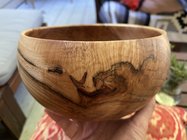
I’ve been interested in Hawaiian bowls since I was stationed on Oahu a decade ago. I got lost in the Bishop museum and was fascinated by the bowls. Calabashes, bowls with teeth, birth bowls. All super interesting.
I’m still not very good at woodturning, but recently decided my taller spalted maple stock looks just about right to start playing around with calabash shapes.
I struggled to get the shape right; the proportions from earlier in the thread helped. Finished product has too much torn grain, that couldn’t be sanded out. I clearly have some technique learning to do.
Thanks for the inspiration and discussion. As always, the AAW forum is a great place to come for ideas.
Nothing like a visit to the Bishop Museum to understand the historical and cultural significance of the Hawaiian Calabash. Some ancient calabashes had, or still have a name; they were sacred and revered. For centuries only the King was allowed to use them, and the common people were only allowed to use gourds. The curve on the bottom of yours is just a hair too pointy, but with your understanding of the calabash, I will call it a Hawaiian Calabash.View attachment 46562
I’ve been interested in Hawaiian bowls since I was stationed on Oahu a decade ago. I got lost in the Bishop museum and was fascinated by the bowls. Calabashes, bowls with teeth, birth bowls. All super interesting.
I’m still not very good at woodturning, but recently decided my taller spalted maple stock looks just about right to start playing around with calabash shapes.
I struggled to get the shape right; the proportions from earlier in the thread helped. Finished product has too much torn grain, that couldn’t be sanded out. I clearly have some technique learning to do.
Thanks for the inspiration and discussion. As always, the AAW forum is a great place to come for ideas.
Really like the shape of your NC pumpkin. I would call it a Hawaiian calabash if you did not add the decorations.Thank you for this response, Emiliano. I’ve pondered your answer, my original, though poorly worded, query, and the subsequent posts.
Working from North Carolina, I might decide to call my bowl a twig pot. No one would believe me, and they would assume I was either daft, or being silly. But what if I call it a Calabash? I had assumed that because it looks like a Calabash, rocks and spins like a calabash, is voluminous like a calabash, made of a single block of wood, is well crafted with a natural finish like a calabash, that I might be able to call it a Calabash. If it walks like a duck, and quacks like a duck………
I became aware of this form a few years back, and was instantly interested. What a great form and wonderful story! So I experimented with shapes like it. Then read a bit including things about you and what you’re doing, and have been impressed.
Then excited for your demo with our club, which I really enjoyed.
Typically at these woodturning club demos the concepts and methods are shared, with the idea that those in attendance might try to copy you, or even better, to learn and then do one’s own take on it. Copy isn’t especially artful or even creative, but shows technical prowess, no doubt. It’s generally thought it’s better to put one’s own personal touch to creations.
Although I had done a rough turn a year before, I went into the final turning after your demo, with what I thought we’re your messages in hand. I’m proud of the piece I finished, certainly made better by your instruction, but a bit saddened and annoyed that my use of the term,” Calabash” is unwelcomed.
You didn’t answer the questions regarding rules for a Calabsh (you did say the ancients made lots of variations ), but pointed to the examples you provided. Not a helpful answer. My take on your responses to questions and your comments to and about other’s attempts is that your interest is in the ancient form, that you strive to craft believable replicas of this form, modern day Calabash copies. Well crafted, heirloom, perhaps museum level, but definitely copies. Not an insult by any means, just by way of definition. Your work is stellar, of that there is little doubt.
Can we just say that to call one‘s bowl a Calabash, it MUST be a replica of one of the documented examples?
I can certainly live with that, and wish you would have stated that at the outset.
Lastly, I apologize for the cultural and family insults I unwittingly made by my errant use of a term much more sacred than I knew.
I will call the bowls I make that are similar, something else.
Huzzah!!I will call it a Hawaiian Calabash.
Emiliano, thanks for the pictures and discussion. You inspired me. Since I don't have easy access to large Koa blanks in Tennessee, I had to do a glue up which took a little while. Turned it yesterday, as always there are a couple things I would do differently. With that said, here's my interpretation of a Calabash. Would love to hear your critique.
11" x 5.5" - Cherry, Sapele, Hickory
11" x 5.5" - Cherry, Sapele, Hickory
Attachments
I've been looking for a copy of the Jenkins book for a while, and until now all the copies I've seen have been over $100. Today when I looked there were a few available in the 60-70 range. If any of you have been wanting this book, pounce on it now!I would hate to set some "rules". Just like us, throughout the centuries, the ancient Hawaiian makers were many. You can see the different styles and all shapes when you visit the Hawaiian Hall at the Bishop Museum in Honolulu. I have lost count of how many times I have visited it. I even spent a few hours talking to a curator about calabashes once. The book by Irving Jenkins, The Hawaiian Calabash, is the bible for anyone wanting to learn more about it. I would say that the main characteristic is a complete round bottom. A good example of what is not a round bottom is what @Rusty Nesmith did with his. That flat spot makes it a nice salad bowl. The simplest one to start with is the low sided. I will add a picture below. It is from the Bishop Museum, so it was made prior to 1778.
Were the tall ones also completely round-bottomed?The hardest shape to pull of is the taller than wider shape. Most were done endgrain, the Pu'ahala.
Kalia
If anyone is interested in learning more about tradition calabash bowls, I would encourage you to read the following article, written by Sharon Doughtie.
It covers everything umeke. I’m sure many of you are familiar with it, but if not give it a read. The writing is fantastic, the history is rich, and the Pat Kramer bowls are superb.
@Emiliano Achaval you mentioned the Jenkins book. Gosh, I would LOVE to get my hands on a copy. With a 1 year old baby and another on the way, the price tag is a bit high right now though. Maybe I’ll get lucky and find an inexpensive copy, or maybe I can ask for it for Christmas.
It covers everything umeke. I’m sure many of you are familiar with it, but if not give it a read. The writing is fantastic, the history is rich, and the Pat Kramer bowls are superb.
@Emiliano Achaval you mentioned the Jenkins book. Gosh, I would LOVE to get my hands on a copy. With a 1 year old baby and another on the way, the price tag is a bit high right now though. Maybe I’ll get lucky and find an inexpensive copy, or maybe I can ask for it for Christmas.
I just picked up a copy of Jenkins book on eBay for $55 shipped. Hope it’s as good as I’ve heard.
Woah, that’s a steal! Last I looked they were all $150+. Maybe I won’t have to wait until Christmas after all.I just picked up a copy of Jenkins book on eBay for $55 shipped. Hope it’s as good as I’ve heard.
Here’s a link to the Jenkins book for $65 or best offer:
https://www.ebay.com/itm/1254791417...RY2qLQiT26&var=&widget_ver=artemis&media=COPY
https://www.ebay.com/itm/1254791417...RY2qLQiT26&var=&widget_ver=artemis&media=COPY
From what I’ve read, even the tall ones were round bottomed. The reason for the round bottom is utilitarian. These bowls were made prior to tabletops, so a flat bottom did not make sense. Instead, a rounded bottom seats better when placed on uneven ground. I suspect that the taller bowls might have needed additional stabilization of some sort, but they still were rounded on the bottom.Were the tall ones also completely round-bottomed?
Kalia
Seller accepted my offer. Thanks for the tip! Christmas in September I guessHere’s a link to the Jenkins book for $65 or best offer:
https://www.ebay.com/itm/1254791417...RY2qLQiT26&var=&widget_ver=artemis&media=COPY
I’m glad you were able to get it. Enjoy!
May be a stupid question but why the round bottom? How do you secure it to turn the inside?Really like the shape of your NC pumpkin. I would call it a Hawaiian calabash if you did not add the decorations.
Pat
It is definitely Calabash-ish Looks like maybe you came in a bit much on the top. The bottom looks right.Emiliano, thanks for the pictures and discussion. You inspired me. Since I don't have easy access to large Koa blanks in Tennessee, I had to do a glue up which took a little while. Turned it yesterday, as always there are a couple things I would do differently. With that said, here's my interpretation of a Calabash. Would love to hear your critique.
11" x 5.5" - Cherry, Sapele, Hickory
They were round bottoms. One of my pre-contact tall calabashes, the book says they were used for medicine, is round bottom, and to stabilize it or maybe because that is the best they could do, the bottom is 1.5 in thick. The reason for the round bottom is that they would reach for the food with their fingers, tilt the bowl towards them, and then the bowl would go upright again. The bowl I have, there are only 3 known in the world, I have the fourth one.Were the tall ones also completely round-bottomed?
Kalia
...you came in a bit much on the top.
Thanks Emiliano, recognized that *after* I read the article Michael Anderson posted. When I do glue-ups like this I usually make enough for a couple/few bowls at once. After studying your pictures and the ones in the article maybe I'll give it another shot next week


